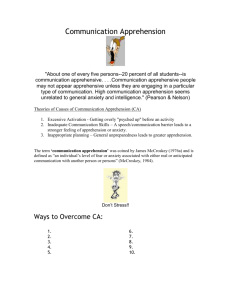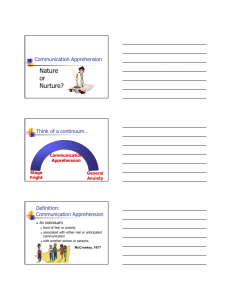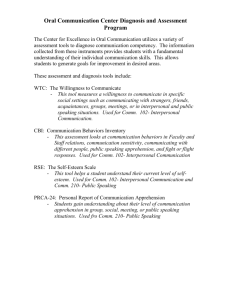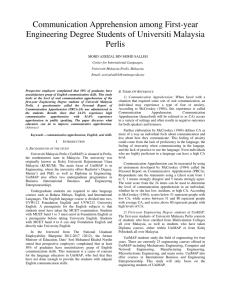Timing
advertisement
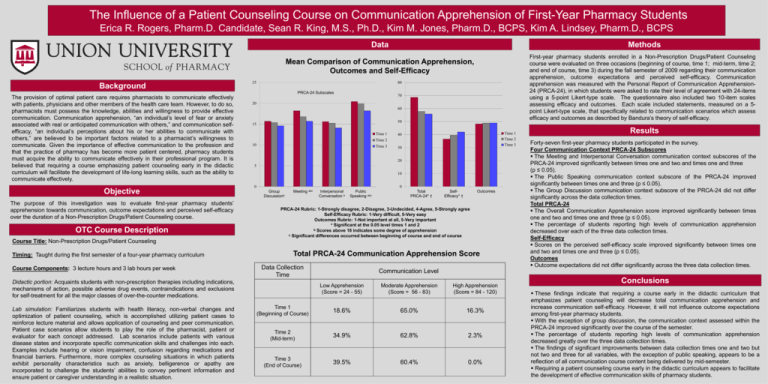
The Influence of a Patient Counseling Course on Communication Apprehension of First-Year Pharmacy Students Erica R. Rogers, Pharm.D. Candidate, Sean R. King, M.S., Ph.D., Kim M. Jones, Pharm.D., BCPS, Kim A. Lindsey, Pharm.D., BCPS Data Methods First-year pharmacy students enrolled in a Non-Prescription Drugs/Patient Counseling course were evaluated on three occasions (beginning of course, time 1; mid-term, time 2; and end of course, time 3) during the fall semester of 2009 regarding their communication apprehension, outcome expectations and perceived self-efficacy. Communication apprehension was measured with the Personal Report of Communication Apprehension24 (PRCA-24), in which students were asked to rate their level of agreement with 24-items using a 5-point Likert-type scale. The questionnaire also included two 10-item scales assessing efficacy and outcomes. Each scale included statements, measured on a 5point Likert-type scale, that specifically related to communication scenarios which assess efficacy and outcomes as described by Bandura’s theory of self-efficacy. Mean Comparison of Communication Apprehension, Outcomes and Self-Efficacy Background 25 80 PRCA-24 Subscales The provision of optimal patient care requires pharmacists to communicate effectively with patients, physicians and other members of the health care team. However, to do so, pharmacists must possess the knowledge, abilities and willingness to provide effective communication. Communication apprehension, “an individual’s level of fear or anxiety associated with real or anticipated communication with others,” and communication selfefficacy, “an individual’s perceptions about his or her abilities to communicate with others,” are believed to be important factors related to a pharmacist’s willingness to communicate. Given the importance of effective communication to the profession and that the practice of pharmacy has become more patient centered, pharmacy students must acquire the ability to communicate effectively in their professional program. It is believed that requiring a course emphasizing patient counseling early in the didactic curriculum will facilitate the development of life-long learning skills, such as the ability to communicate effectively. Objective The purpose of this investigation was to evaluate first-year pharmacy students’ apprehension towards communication, outcome expectations and perceived self-efficacy over the duration of a Non-Prescription Drugs/Patient Counseling course. OTC Course Description 70 20 60 50 15 Time 1 Time 1 Time 2 Time 3 40 Time 2 10 Time 3 30 20 5 10 0 0 Group Discussionᵇ Meeting ᵃᵇᶜ Interpersonal Conversation ᵇ Public Speaking ᵃᵇᶜ Total PRCA-24* † Outcomes SelfEfficacy* † PRCA-24 Rubric: 1-Strongly disagree, 2-Disagree, 3-Undecided, 4-Agree, 5-Strongly agree Self-Efficacy Rubric: 1-Very difficult, 5-Very easy Outcomes Rubric: 1-Not important at all, 5-Very important ᵃ Significant at the 0.05 level times 1 and 2 ᵇ Scores above 18 indicates some degree of apprehension ᶜ Significant differences occurred between beginning of course and end of course Course Title: Non-Prescription Drugs/Patient Counseling Timing: Taught during the first semester of a four-year pharmacy curriculum Course Components: 3 lecture hours and 3 lab hours per week Total PRCA-24 Communication Apprehension Score Data Collection Time Didactic portion: Acquaints students with non-prescription therapies including indications, mechanisms of action, possible adverse drug events, contraindications and exclusions for self-treatment for all the major classes of over-the-counter medications. Lab simulation: Familiarizes students with health literacy, non-verbal changes and optimization of patient counseling, which is accomplished utilizing patient cases to reinforce lecture material and allows application of counseling and peer communication. Patient case scenarios allow students to play the role of the pharmacist, patient or evaluator for each concept addressed. Lab scenarios include patients with various disease states and incorporate specific communication skills and challenges into each. Examples include hearing or vision impairment, confusion regarding medications and financial barriers. Furthermore, more complex counseling situations in which patients exhibit personality characteristics such as anxiety, belligerence or apathy are incorporated to challenge the students’ abilities to convey pertinent information and ensure patient or caregiver understanding in a realistic situation. Results Forty-seven first-year pharmacy students participated in the survey. Four Communication Context PRCA-24 Subscores The Meeting and Interpersonal Conversation communication context subscores of the PRCA-24 improved significantly between times one and two and times one and three (p ≤ 0.05). The Public Speaking communication context subscore of the PRCA-24 improved significantly between times one and three (p ≤ 0.05). The Group Discussion communication context subscore of the PRCA-24 did not differ significantly across the data collection times. Total PRCA-24 The Overall Communication Apprehension score improved significantly between times one and two and times one and three (p ≤ 0.05). The percentage of students reporting high levels of communication apprehension decreased over each of the three data collection times. Self-Efficacy Scores on the perceived self-efficacy scale improved significantly between times one and two and times one and three (p ≤ 0.05). Outcomes Outcome expectations did not differ significantly across the three data collection times. Communication Level Low Apprehension (Score = 24 - 55) Moderate Apprehension (Score = 56 - 83) High Apprehension (Score = 84 - 120) Time 1 (Beginning of Course) 18.6% 65.0% 16.3% Time 2 (Mid-term) 34.9% 62.8% 2.3% Time 3 (End of Course) 39.5% 60.4% 0.0% Conclusions These findings indicate that requiring a course early in the didactic curriculum that emphasizes patient counseling will decrease total communication apprehension and increase communication self-efficacy. However, it will not influence outcome expectations among first-year pharmacy students. With the exception of group discussion, the communication context assessed within the PRCA-24 improved significantly over the course of the semester. The percentage of students reporting high levels of communication apprehension decreased greatly over the three data collection times. The findings of significant improvements between data collection times one and two but not two and three for all variables, with the exception of public speaking, appears to be a reflection of all communication course content being delivered by mid-semester. Requiring a patient counseling course early in the didactic curriculum appears to facilitate the development of effective communication skills of pharmacy students.
